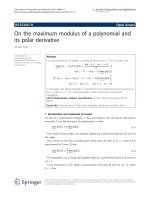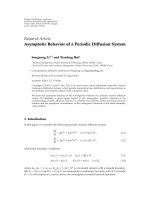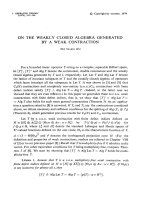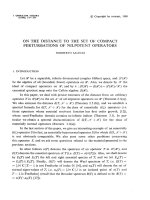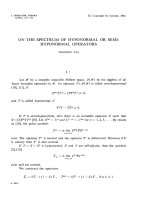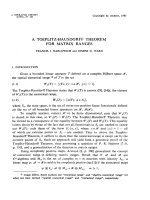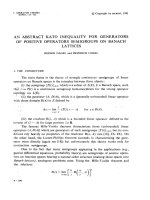Báo cáo toán học: "On the Asymptotic Behavior of Solutions of a Nonlinear Difference Equation with Bounded Multiple Delay" pptx
Bạn đang xem bản rút gọn của tài liệu. Xem và tải ngay bản đầy đủ của tài liệu tại đây (118.81 KB, 8 trang )
Vietnam Journal of Mathematics 34:2 (2006) 163–170
On the Asymptotic Behavior of Solutions
of a Nonlinear Difference Equation
with Bounded Multiple Delay
Dinh Cong Huong
Hanoi Univ. of Science, 334 Nguyen Trai, Thanh Xuan, Hanoi, Vietnam
Quy Nhon University, 170 An Duong Vuong, Quy Nhon, Binh Dinh, Vietnam
Received April 24, 2005
Revised October 13, 2005
Abstract. In this paper, we study the asymptotic behavior of solutions of a nonlinear
difference equation with bounded multiple delay
x
n+1
= λ
n
x
n
+
r
i=1
α
i
(n)F (x
n−m
i
).
We give conditions implying that this equation has solutions which are oscillatory,
bounded, convergence or periodic.
2000 Mathematics Subject Classification: 39A12.
Keyword: Nonlinear difference equation, bounded multiple delay, asymptotic behaviour,
oscillatory, boundedness, converging, periodicity.
Introduction
The asymptotic behavior of solutions of delay nonlinear difference equations has
been studied extensively in recent years; see for example [1-9]. Our main moti-
vation in studying asymptotic behavior of solutions of delay nonlinear difference
equation
x
n+1
= λ
n
x
n
+
r
i=1
α
i
(n)F (x
n−m
i
)
164 Dinh Cong Huong
is the oscillation of solutions of the difference equation
x
n+1
− x
n
+ p
n
x
n−m
=0,n∈ N
in [1]; the positive periodic solutions of nonlinear delay functional difference
equations
x
n+1
= a
n
x
n
± βh
n
f(x
n−τ
n
)
in [8] and the extinction, persistence, global stability and nontrivial periodicity
in the model
x
n+1
= λx
n
+ F(x
n−m
)
of population growth in [2, 3]. In this paper, to investigate the oscillation,
we let λ
n
=1foralln ∈ N and to study the boundedness, the convergence,
the periodicity we will give some restrictions on the function F , the sequences
{λ
n
}
n
, {α
i
(n)}
n
or the delays m
i
. Our results can be considered as the general-
ization of some earlier results in [1, 2].
1. The Oscillation
Consider the difference equation
x
n+1
= x
n
+
r
i=1
α
i
(n)F (x
n−m
i
) (1.1)
for n ∈ N,n a for some a ∈ N,wherer, m
i
1, 1 i r are fixed positive
integers, the functions α
i
(n) are defined on N and the function F is defined on
R. Recall that, a solution {x
n
}
na
of (1.1) is called oscillatory if for any n
1
a
there exists n
2
n
1
such that x
n
2
x
n
2
+1
0. The difference equation (1.1) is
called oscillatory if all its solutions are oscillatory. The following theorem and
its corollary give some sufficient conditions for the oscillation of the solutions of
(1.1).
Theorem 1. Assume that
xF (x) < 0,x=0 and lim inf
x→0
F (x)
x
= M<0.
Then, (1.1) is oscillatory if the following holds
r
i=1
(lim inf
n→∞
α
i
(n)) · M ·
(m
i
+1)
m
i
+1
m
m
i
i
< −1(1.2)
where α
i
(n) 0,n∈ N, 1 i r.
Proof. We first prove that the inequality
x
n+1
− x
n
−
r
i=1
α
i
(n)F (x
n−m
i
) 0,n∈ N (1.3)
On the Asymptotic Behavior of Solutions of a Nonlinear 165
has no eventually positive solution. Indeed, assume the contrary and let {x
n
}
n
be a solution of (1.3) with x
n
> 0 for all n n
1
,n
1
∈ N. Setting v
n
=
x
n
x
n+1
and
dividing this inequality by x
n
,weobtain
1
v
n
1+
r
i=1
α
i
(n)
F (x
n−m
i
)
x
n−m
i
v
n−m
i
···v
n−1
, (1.4)
where n n
1
+ m, m =max
1ir
m
i
.
Clearly, x
n
is nonincreasing with n n
1
+m,andsov
n
1 for all n n
1
+m.
Also, v
n
is bounded above because otherwise (1.2) and (1.4) imply that v
n
< 0for
arbitrarily large n. Put lim inf
n→∞
v
n
= β.NoticethatF (x
n−m
i
) < 0, ∀i =
1, 2, ···r, we get
lim sup
n→∞
1
v
n
=
1
β
1 − lim inf
n→∞
r
i=1
α
i
(n)
−
F (x
n−m
i
)
x
n−m
i
v
n−m
i
···v
n−1
1+
r
i=1
(lim inf
n→∞
α
i
(n)) · M · β
m
i
,
1
r
i=1
(lim inf
n→∞
α
i
(n)) · M ·
β
m
i
+1
1 − β
.
But
β
m
i
+1
1 − β
−
(m
i
+1)
m
i
+1
m
m
i
i
,i=1, 2, ···r,
so
r
i=1
(lim inf
n→∞
α
i
(n)) · M ·
(m
i
+1)
m
i
+1
m
m
i
i
−1.
This contradicts our assumption, hence (1.3) has no eventually positive solution.
Similarly, we can prove that the inequality
x
n+1
− x
n
−
r
i=1
α
i
(n)F (x
n−m
i
) 0,n∈ N
has no eventually negative solution. So, the proof is complete.
Corollary. Assume that α
i
(n) 0,n∈ N, 1 i r,
xF (x) < 0,x=0 and lim inf
x→0
F (x)
x
= M<0.
Then, (1.1) is oscillatory if either of the following holds
M ·
r
i=1
(lim inf
n→∞
α
i
(n)) ·
(˜m +1)
˜m+1
˜m
˜m
< −1,
or
M · r
r
i=1
(lim inf
n→∞
α
i
(n))
1
r
·
(ˆm +1)
ˆm+1
ˆm
ˆm
< −1,
166 Dinh Cong Huong
where ˜m =min
1ir
m
i
, ˆm =
1
r
r
i=1
m
i
.
The proofs of the following theorems can be obtained similarly as the proofs
of Theorem 6.20.1, Theorem 6.20.2 in [1], so we omit them here.
Theorem 2. Assume that
xF (x) < 0,x=0 and lim inf
x→0
F (x)
x
= M<0.
Suppose further that, F is nonincreasing on R and
lim sup
n→∞
r
i=1
n
=n−m
∗
α
i
() > −
1
M
,
where m
∗
=max
1ir
m
i
and α
i
(n) 0,n ∈ N, 1 i r.Then,(1.1) is
oscillatory.
Theorem 3. Assume that
xF (x) < 0, −F (x) x, x =0
and F is nonincreasing on R.Then,(1.1) is oscillatory if the following holds
lim inf
n→∞
r
i=1
α
i
(n) > 0 and lim sup
n→∞
r
i=1
α
i
(n) > 1 − lim inf
n→∞
r
i=1
α
i
(n).
2. Convergence, Boundedness and Periodicity
Consider the difference equation
x
n+1
= λ
n
x
n
+
m
i=1
α
i
F (x
n−i
)(2.1)
for n =0, 1, 2, ···,whereα
i
0,i=1, 2, ··· ,m;
m
i=1
α
i
=1;F :[0, ∞) →
[0, ∞) is a continuous function, and m>0 is a fixed integer. The positive initial
values x
−m
,x
−m+1
, ··· ,x
0
are given. The following theorem gives a sufficient
condition for the convergence to zero of the solutions of (2.1).
Theorem 4. Assume that λ
n
∈ (0, 1) and there exists λ
∗
∈ (0, 1) such that
λ
n
λ
∗
for all n ∈ N. Then, every solution of (2.1) converges to 0 if F (u) <
(1 − λ
∗
)u for all u>0.
Proof. First assume that F (u) < (1 − λ
∗
)u for all u>0. Let {x
n
}
n
be a
positive solution of (2.1) and M =max
−mj0
x
j
.Weprovethatx
n
M for
all n. Indeed using induction assume that x
k
M for all k n. Then by the
difference equation (2.1)
On the Asymptotic Behavior of Solutions of a Nonlinear 167
x
n+1
= λ
n
x
n
+
m
i=1
α
i
F (x
n−i
)
λ
∗
M +
m
i=1
α
i
(1 − λ
∗
)M = M.
Therefore x
n
M for all n.LetM
1
= lim sup
n→∞
x
n
. It is clear that 0
M
1
< ∞. Moreover, there is a subsequence {n
k
} such that
M
1
= lim
k→∞
x
n
k
.
Let >0 be given. There exists a positive integer N = N() such that for all
n
k
>Nwe have M
1
− x
n
k
M
1
+ and for all n>N−m− 1:x
n
M
1
+.
On the other hand,
x
n
k
= λ
n
k
x
n
k
−1
+
m
i=1
α
i
F (x
n
k
−1−i
).
By the mean value theorem, we can choose a sequence {y
n
k
} such that
m
i=1
α
i
F (x
n
k
−1−i
)=F (y
n
k
),
where
y
n
k
∈ [min{x
n
k
−2
, ··· ,x
n
k
−1−m
}, max{x
n
k
−2
, ··· ,x
n
k
−1−m
}].
So we obtain
x
n
k
= λ
n
k
x
n
k
−1
+ F(y
n
k
),
x
n
k
λ
∗
x
n
k
−1
+ F(y
n
k
) <λ
∗
x
n
k
−1
+(1− λ
∗
)y
n
k
,
λ
∗
x
n
k
−1
>x
n
k
− (1 − λ
∗
)y
n
k
M
1
− − (1 − λ
∗
)(M
1
+ ),
x
n
k
−1
M
1
−
2 − λ
∗
λ
∗
.
Thus
M
1
−
2 − λ
∗
λ
∗
x
n
k
−1
M
1
+
and
lim
k→∞
x
n
k
−1
= M
1
.
Similarly, we get
M
1
−
1+λ
∗
λ
∗
y
n
k
M
1
+
and
lim
k→∞
y
n
k
= M
1
.
Because F is continuous, M
1
is a solution of equation u = λ
∗
u + F (u). But, by
assumption F (u) < (1 − λ
∗
)u for all u>0wehaveM
1
= 0 i.e the sequence
{x
n
}
n
converges to 0.
168 Dinh Cong Huong
Remark.
(i) If λ
n
= λ
∗
∈ (0, 1), ∀n ∈ N, then the converse of Theorem 4 is true.
(ii) If {λ
n
}
n
is a monotone sequence where λ
n
∈ (0, 1) for all n ∈ N, then the
conclusion of Theorem 4 is also true. Namely, in the case {λ
n
}
n
is increasing,
we can choose λ
∗
= lim
n→∞
λ
n
;inthecase{λ
n
}
n
is decreasing, we can choose
λ
∗
= λ
0
.
(iii) Due to the proof of Theorem 4, one can easily see that if either m = {m
n
}
n
is bounded or unbounded but lim
n→∞
(n − m
n
)=∞ holds and
m
n
i=1
α
i
=1
then Theorem 4 remains true.
The following theorem gives a sufficient condition for the boundedness of
every solution of (2.1).
Theorem 5. Assume that the sequence {λ
n
}
n
is as in Theorem 4 and F (x)=
H(x, x),whereH :[0, ∞) × [0, ∞) → [0, ∞) is a continuous function, increasing
in x but decreasing in y and H(x, y) > 0 if x, y > 0. Suppose further that
lim sup
x,y→∞
H(x, y)
x
< 1 − λ
∗
, (2.2)
Then every solution {x
n
}
∞
n=−m
of (2.1) is bounded.
Proof. The proof follows from applying the mean value theorem and the proof
of Theorem 2 in [2].
To study the periodicity in the equation (2.1) we assume that {λ
n
}
n
is p−
periodic for p is an integer with p ≥ 1and0<λ
n
< 1 for all n ∈ [0,p− 1]. Let
G(n, u)=
n+p−1
s=u+1
λ
s
1 −
n+p−1
s=n
λ
s
,η=
G(n, n)
G(n, n + p − 1)
,
A =max
n∈[0,p−1]
p−1
u=0
G(n, u),B=min
n∈[0,p−1]
p−1
u=0
G(n, u),
1
= lim
x→∞
F (x)
x
∈ (0, ∞),
2
= lim
x→0
F (x)
x
∈ (0, ∞).
The following therems can be proved similarly as Theorem 2.3, Theorem 2.4 in
[8].
Theorem 6. If one of two following conditions is satisfied
1
>
1
ηB
and
2
<
1
A
(2.3)
or
1
<
1
A
and
2
>
1
ηB
(2.4)
then (2.1) has at le ast one positive periodic solution.
Theorem 7. If either
On the Asymptotic Behavior of Solutions of a Nonlinear 169
1
=0an d
2
= ∞ (2.5)
or
1
= ∞ and
2
=0 (2.6)
then (2.1) has at least one positive periodic solution.
Now, to apply the results of Theorem 6 and Theorem 7 we will construct
some examples. In [8], although the author obtained sufficient conditions for the
existence of multiple positive periodic solutions of the nonlinear delay functional
difference equation
x
n+1
= λ
n
x
n
± βh
n
f(x
n−τ
n
),
but he did not give any illustrative examples.
Example. Consider the following nonlinear difference equations with bounded
delay
x
n+1
= λ
n
x
n
+
m
i=1
α
i
γ
1
x
n−i
1+x
n−i
1+cx
n−i
,γ
1
> 0,c ≥ 1, (2.7)
x
n+1
= λ
n
x
n
+
m
i=1
α
i
γ
2
x
n−i
δ + σe
−χx
n−i
, (2.8)
where {λ
n
}
n
is 2− periodic. We have
λ
n
=
1
2
(α + β)+(α − β)(−1)
n
,λ
0
= α, λ
1
= β, α, β ∈ (0, 1).
It is easy to check that
A =max
n∈[0,1]
1
u=0
G(n, u)=
β +1
1 − αβ
,
B =min
n∈[0,1]
1
u=0
G(n, u)=
α(β +1)
1 − αβ
,
η =
β, if n =2k, k ∈ N
α, if n =2k +1,k ∈ N.
For (2.7), since
1
= lim
x→∞
F (x)
x
=
γ
1
c
∈ (0, ∞),
2
= lim
x→0
F (x)
x
= γ
1
∈ (0, ∞),
the condition (2.4) in Theorem 6 becomes
1−αβ
β+1
<γ
1
<c.We can choose
α, β ∈ (0, 1) and c 1 satisfying this inequality so by Theorem 6, (2.7) has at
least one positive periodic solution.
170 Dinh Cong Huong
For (2.8), since
1
= lim
x→∞
F (x)
x
=
γ
2
δ
∈ (0, ∞),
2
= lim
x→0
F (x)
x
=
γ
2
δ + σ
∈ (0, ∞),
the condition (2.3) in Theorem 6 implies
1
δ
>
1
δ+σ
. Hence, the condition (2.3) in
Theorem 6 is satisfied for all γ
2
,δ,σ,χ ∈ (0, ∞). This means that (2.8) has at
least one positive periodic solution.
Note that, if we choose { λ
n
}
n
as above and F (x)=constantorF (x)=
a
x
,a>0,x∈ (0, +∞) then Theorem 7 is applied, i.e. (2.7), (2.8) always have
at least one positive periodic solution.
Acknowledgement.
The author would like to thank Prof. Pham Ky Anh, Dr. Vu
Hoang Linh and the referees for useful comments, which improve the presentation of
this paper.
References
1. R. P. Agarwal, Difference Equations and Inequalities. Theory, Methods, and Ap-
plications, Marcel Dekker Inc., New York, 2000.
2. Dang Vu Giang and Dinh Cong Huong, Extinction, persistence and global stabil-
ity in models of population growth, J. Math. Anal. Appl. 308 (2005) 195–207.
3. Dang Vu Giang and Dinh Cong Huong, Nontrivial periodicity in discrete delay
models of population growth, J. Math. Anal. Appl. 305 (2005) 291–295.
4. I. Gy˝ori and G. Ladas and P. H. Vlahos, Global attraction in a delay difference
equation, Nonlin. Anal. 17 (1991) 473–479.
5. G. Karakostas, Ch. G. Philos, and Y. G. Sficas, The dynamics of some discrete
population models, Nonlin. Anal. 17 (1991) 1069–1084.
6. J. G. Milton and J. Belair, Chaos, noise and extinction in models of population
growth, Theo. Pop. Biol. 17 (1990) 273–290.
7. A. F. Ivanov, On global stability in a nonlinear discrete model, Nonlin. Anal. 23
(1994) 1383–1389.
8. Yousseff N. Raffoul, Positive periodic solutions of nonlinear delay functional dif-
ference equations, Elec. J. Diff. Eqs. 55 (2002) 1–8.
9. D. Singer, Stable orbits and bifurcation of maps of the interval, Siam J. App.
Math. 35 (1978) 260–267.
